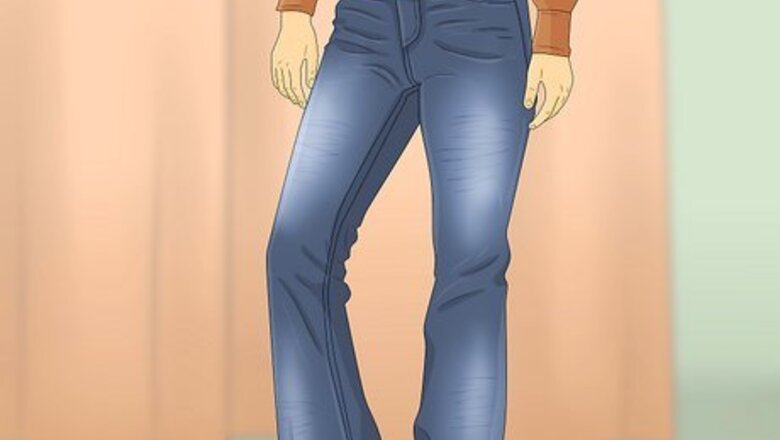
views
Getting Yourself Ready
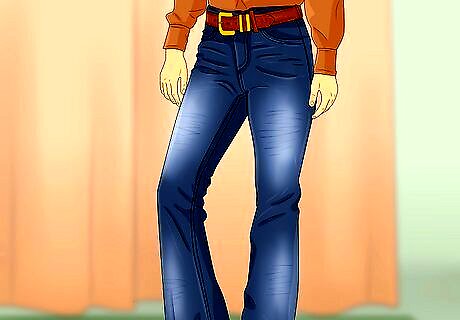
Wear long pants to protect your legs from rubbing against the saddle. It is helpful to wear long-sleeved clothing to protect against rubbing or chafing. Your pants should fit your body, rather than being loose. Loose clothing can cause injury when riding because it may get caught in the saddle or on other things along the trail. Wear riding pants, if you can. These are stretchy pants without an inseam. They also have suede patches along the inner knee area to help with grip. Jeans are comfortable options for horseback riding.
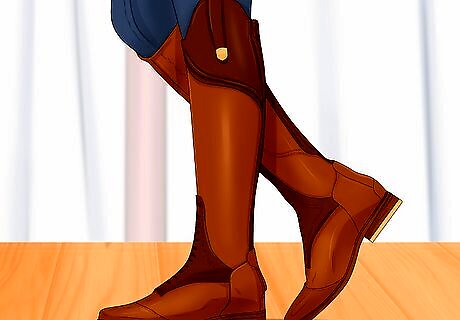
Wear boots with a small heel to keep your feet in the stirrups. Wearing shoes with heels is helpful because you can keep your foot securely in the stirrups. You can wear riding boots, hiking boots, winter boots, and boots that come above your ankle. If you don’t have boots, you can use closed-toed shoes like running shoes or sneakers.

Put on a riding helmet before you get on the horse. A helmet is one of the most critical pieces of riding equipment because it protects you any time you get hit or your horse takes off. Measure the size of your head with a tape measure to find your helmet size. Most helmets have padding inside, which help the helmet fit snug around your head. Place the helmet on your head, and try a new size if it is wobbly or too tight. When you find a helmet that fits, buckle the chin strap and adjust the strap to hold the helmet in place. If you are taking lessons, most stables provide helmets. The brim of your helmet should sit about 1 inch (2.5 cm) above your eyebrows and level across your face. If you don’t have a riding helmet, put on a bicycle helmet. You must wear a helmet to prevent head injuries when riding.
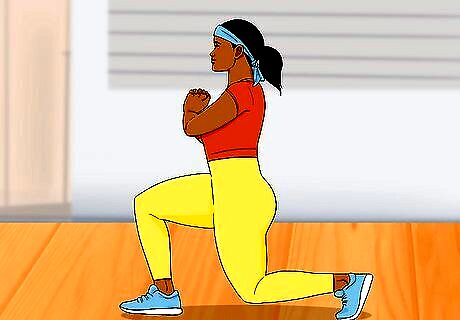
Work out 5-6 days a week to get in shape to ride a horse. Horseback riding requires good overall fitness, strength, and endurance because you will be using many muscles as you ride. Build your muscles with exercises like sit ups, push ups, planks, and lifting weights. Do aerobic exercises for 30 minutes a day to help you develop endurance. Try aerobic exercises like walking, running, biking, and swimming. If you can't do get aerobic exercise every day, aim to exercise at least 3 times a week. You should also practice good posture and stretch regularly.
Tacking up Your Horse
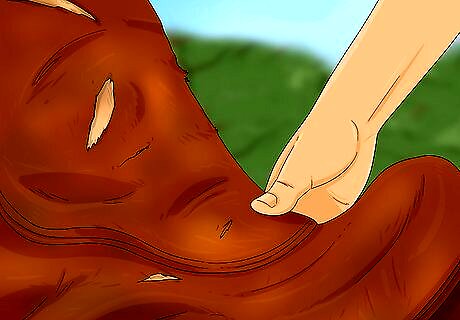
Check your saddle and pad to make sure they are fit for use. Inspect the equipment to ensure everything works properly and that there are no dirt or foreign objects on the saddle or saddle pad. Look for any tangles in the straps or any objects stuck to the pad or saddle. For example, if a burr is left under the saddle pad, your horse could buck when you sit on the saddle.

Place your saddle pad over your horse’s back gently. Approach the horse from the left side, and drape the saddle pad over the horse’s back. Place the pad just in front of the horse’s withers (the highest part of a horse's back). Make sure you let go of the saddle pad gently. If your horse is younger or unfamiliar, you can let them smell the saddle pad before you put it on.
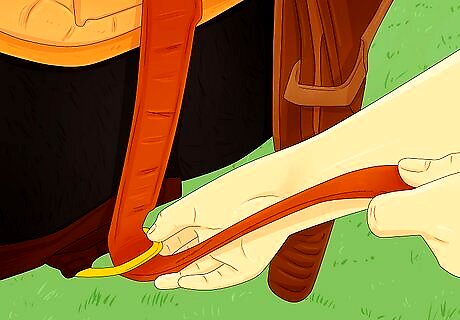
Hook the stirrups over the saddle horn and adjust them into place. The stirrups are attached to the saddle by a leather strap, and this is the part of the saddle where you place your feet. The saddle horn is a nub at the top of the saddle you can use to help you get into the saddle. Place the cinches of the right stirrup over the seat of the saddle, and buckle them in place, then do the same for the left stirrup. Avoid approaching your horse by carrying a saddle so the cinches drag at your feet. This could cause injuries.
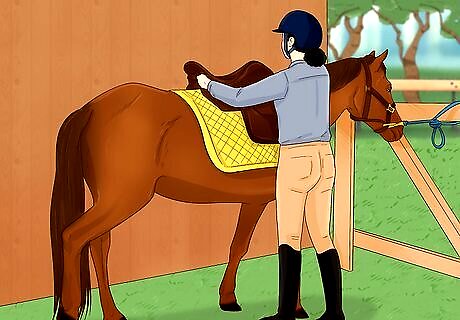
Place the saddle onto the horse’s back. Swing the saddle over your horse’s back and place it down gently. It should easily fit over top of your horse, and you should place it directly on top of the saddle pad. Avoid dropping the saddle or placing it down roughly. This may scare or hurt your horse. If you need to move the saddle or pad, lift it up rather than sliding it. Sliding can pull or bind the horse’s hair and cause a sore back.
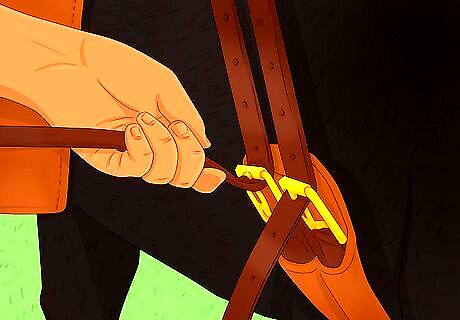
Tighten the girth around your horse so the saddle stays in place. After you have the saddle and pad in place, move to the right side of the horse and adjust the cinch and girth so they fit snug around their body. Tighten the cinches slowly and gradually so you don’t scare the horse. Connect the back cinch to the front cinch so it doesn't slide into the horse’s flank. If the horse is known to kick, have a friend help. They can pass you the cinch from the other side of the horse.
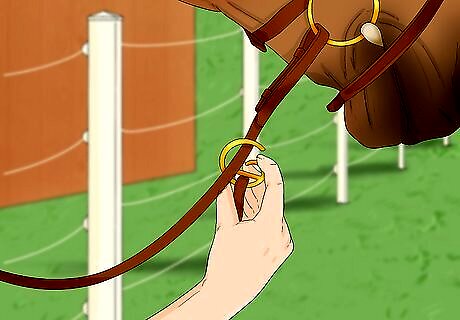
Fasten any accessory equipment to the saddle or horse. If you are using horse riding accessories like a collar, martingale, or tie-down, attach it to the tack or place it on the horse after you tack up your horse. Collars and martingales are used when your horse is pulling a cart or carriage.
Putting on the Bridle
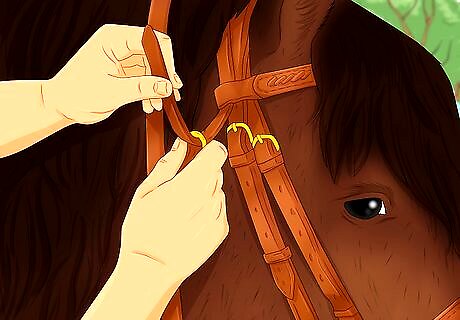
Check your bridle so the straps are in place and properly attached. Before you put the bridle on your horse, inspect it to make sure nothing is tangled or twisted and that the bit is not crooked or slanted. If something is out of place or twisted, it will make it difficult to put the bridle on the horse and it could cause injury when riding. This makes it easier to put the bridle on.

Remove the halter from the left side of the horse. Slip the nosepiece of the halter off of your horse, and bring your horse’s head down toward you. Lowering the horse’s head makes it easier to put on the bridle. It is helpful to have the bridle and reins on your arm ready to put on.
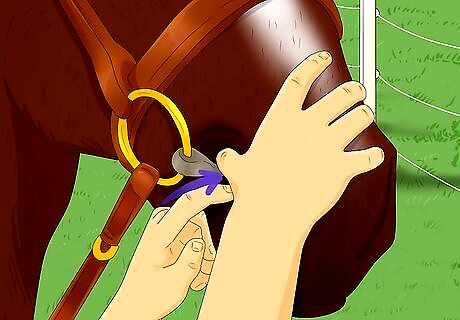
Insert the bit into your horse’s mouth. Place your left index finger at the front of your horse’s mouth between his top and bottom teeth, and guide the bit into their mouth. When the horse opens their mouth, slide the bit in so it sits on top of their tongue. As you do this, pull up on the bit with your right hand to secure it into place. Pulling up with your right hand, keep the bit taut.
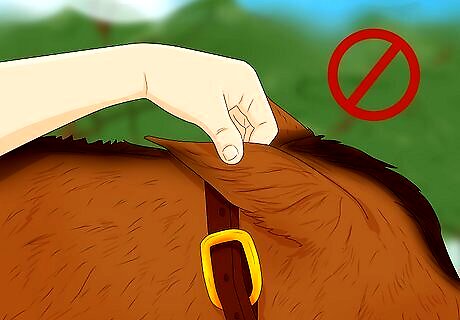
Place the crown piece and the throat latch behind the horse’s ears. Gently bend the horse’s ears forward and slide the bridle onto their head. The browband of the bridle sits across the horse’s forehead. Make adjustments to the browband on both sides so it sits just below the horse’s ears. Avoid bending the horse’s ears backwards, as this is very uncomfortable them.

Buckle the throat latch strap around the horse’s head. The throat latch is a leather strap that keeps the bridle around the horse’s head. Feed the leather strap through the buckle and fasten it around the horse so it is secure around the throat. Make sure you don’t fasten it too tightly so you don’t restrict the horse’s breathing. You should be able to fit your fist through the throat latch strap when it is buckled.
Mounting Your Horse

Pick a safe spot to get onto your horse and check your tack. Before you mount your horse, make sure they are in a place where they will not be spooked. Move them away from buildings, fences, people, other horses, or trees before you mount the horse. Double-check your tack to make sure everything is secure, particularly the girth. You can also make sure the stirrups are properly adjusted to fit your feet.

Use a mounting block if you need help getting on the horse. Mounting blocks are miniature sets of stairs used to help a rider mount a horse. Put the block on the horse’s left side, and place the reins over the horse’s head. Climb the stairs to easily get on your horse. Mounting blocks also put less strain on the stirrups when you get on the horse, which decreases the chance of slipping. Mounting blocks also make your mount smooth, which in turn makes your horse less likely to spook.
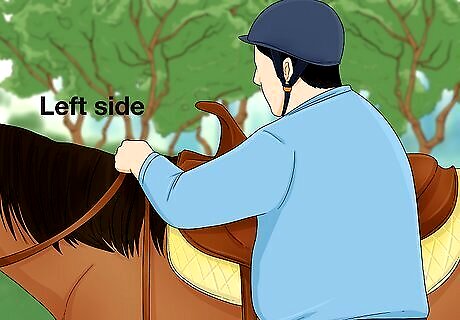
Stand to the left of your horse and grasp the reins with your left hand. It is typical to mount a horse from the left side. Place the reins in your left hand so you can control the horse when you get in the saddle. The right side of the horse is known as the “off” side.
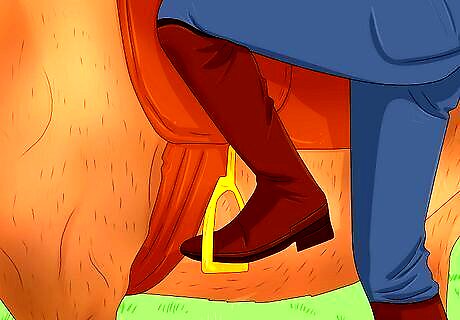
Position your left foot in the left stirrup. It is helpful to place the heel of your boot at the edge of the stirrup. Hold onto the saddle to steady yourself, if you need to. Your foot should be completely inside the stirrup.
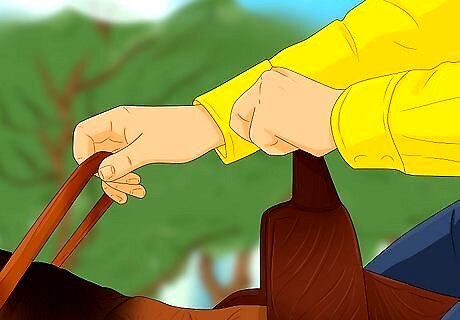
Grab the saddle horn with your hand and pull yourself onto the saddle. Put your left hand on the saddle horn to help you get on the saddle. Then, jump up slightly to raise yourself onto your horse, and swing your right leg around the horse’s body. Place your right foot in the stirrup when you reach the other side. Move your right hand forward as you do this and take hold of the rein with your right hand.
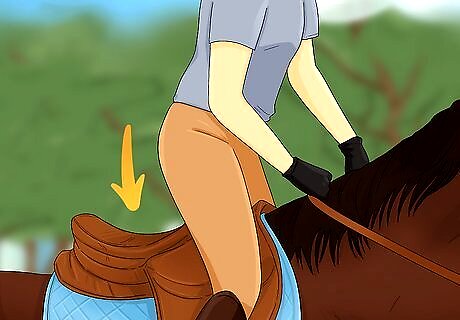
Lower yourself slowly into the saddle. When both feet are securely in the stirrups and you have the reins in both hands, sit into the saddle carefully and gradually. You are now ready to ride your horse! If you drop into the saddle quickly, you could startle the horse and they could jump or buck.











Comments
0 comment